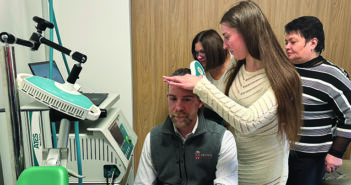New youth hockey rules draw on Brown research to reduce concussions.
Peter Kriz, MD, was a general pediatrician in private practice in 2005 when he saw a patient who changed the trajectory of his career. As Kriz stood outside the exam room and read the high school hockey player’s medical chart, he overheard the boy’s father coaching him on how to pass a test that is administered to patients who suffer concussions; this concussion was the boy’s third. “Think of it as a phone number” was the advice the father provided to recall the reverse digit spans used to assess concentration on the concussion assessment testing.
“I thought, ‘This is crazy.’ The most important thing to this father is trying to get his kid back into the game,” Kriz says. “I realized that we needed more doctors trained in managing sports concussions and their effects.”
Today, he’s an associate professor of orthopaedics and of pediatrics, and an assistant team physician at Brown, where his research interests include injury prevention in youth sports and sport-related concussions. Kriz is particularly interested in studying what happens when youth and high school sports teams are organized by skill level rather than age, size, and physical maturity level, especially in ice hockey.
Size Matters
That’s how teams are formed in high school sports, so it’s not uncommon for a highly skilled 14-year-old to participate alongside and play against an 18-year-old, particularly in ice hockey, according to Mike Lunney, assistant executive director of the Rhode Island Interscholastic League. The RIIL supervises and administers athletic programs for 60 public, private, and parochial high schools across Rhode Island.
After treating a high school freshman in 2011 for his second concussion—inflicted by an older player during a travel ice hockey game—Kriz grew troubled by the discrepancy between the players’ size and physical maturity, combined with what he described as a culture among some youth ice hockey players of targeting and injuring younger players.
“I saw how one player’s malicious play could have a lasting impact,” he says.

Kriz collaborated with colleagues at Brown, Hasbro Children’s Hospital, Boston Children’s Hospital, and South Shore Hospital in South Weymouth, MA, on a study to examine the association between physical maturity and the risk of prolonged concussion symptoms. While the long-held belief in the medical community is that most pediatric concussions resolve in 28 days, Kriz and his colleagues hypothesized that younger players took more time to recover.
The study, published in the Journal of Pediatrics in 2016, evaluated 145 concussed male and female ice hockey players between the ages of 13 and 18. They found that male players who were less physically mature took about 55 days to recover, compared to about 30 days for their more physically mature counterparts. Ultimately, the researchers found that nearly half of pediatric concussions took longer than 28 days to heal.
“After three weeks, the child may no longer have headaches, so he’ll return to school, and maybe even resume playing the sport. But other studies using advanced neuroimaging on children who sustained concussions found that after a month, many still had significant alterations in cerebral blood flow,” Kriz says.
Wall of Shame
Kriz took his findings to the RIIL, where he was a member of the Sports Medicine Advisory Committee. The committee is responsible for bringing forward concerns related to players’ safety.
The RIIL had been trying to eliminate “flagrant hits” from its ice hockey games, while maintaining the integrity of the game, Lunney says.
Armed with Kriz’s research, coaches and other members of the RIIL worked together to create new statewide guidelines to discourage players from accumulating penalties for game misconduct, including flagrant penalties such as purposely targeting other players.
Under the new guidelines, any player who accumulates 50 or more penalty minutes in a regular season will be suspended for two league games, as well as any game in between. Players who accumulate 70 or more penalty minutes will be suspended for the remainder of the hockey season, including the playoffs.
Additionally, the Rhode Island Hockey Coaches Association (RIHCA), which works with the RIIL, now has what Kriz calls a “wall of shame,” an area on the RIHCA website that lists the names, teams, and total penalty minutes of any player who has accrued more than 25 penalty minutes. This section, called “Penalty Watch,” is included in the stats for every division.
“All of a sudden, they see themselves getting called out, and not in a good way,” Lunney says.
Since implementing the new guidelines, the RIIL has seen a reduction in the number of penalties among its ice hockey players, he adds.
“The intent is not to reduce participation, but it’s really under the players’ control whether they hit that penalty threshold. The proof is in the results,” Lunney says.
Meanwhile, Kriz collected the penalty data from the RIHCA, as well as injury data from local hospitals, to determine the effect of what he calls the penalty infraction minute (PIM) rule change. His study, published in the American Journal of Sports Medicine in February, found that the PIM rule change significantly reduced the number of all injuries, concussion/closed head injuries, and upper body injuries among high school ice hockey players who play in the RIIL.
Game Changer
Kriz makes the case for PIM rule changes in not only ice hockey but in all youth collision sports as a way to mitigate injury risk without “fundamentally changing the sport,” he says.
Kriz and Lunney both hope the rule change will eventually be implemented regionally before becoming a national rule.
An advocate of fair play in all sports, Kriz partnered with Dawn Comstock, PhD, an epidemiologist at the University of Colorado Denver to analyze the effectiveness of yellow card accumulation policies in US high school sports in reducing injury rates in boys’ and girls’ soccer. Rhode Island is one of 15 states to have such a policy in effect, initiated in the 20082009 season. Kriz and Comstock hope to present their findings at the Pediatric Research in Sports Medicine meeting in January 2020.
“I’m passionate about making sports safer without changing the fundamental aspects of the game,” Kriz says. “Team sports, including contact/collision sports, afford kids so many great opportunities that will positively impact their lives, including promoting lifelong fitness. Let’s not throw the baby out with the bathwater. Let’s give rule changes and educational programs an opportunity to reduce the risk of injury in youth and high school sports.”




